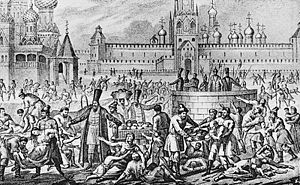Russian famine of 1601–1603 facts for kids
The Great Russian Famine of 1601–1603 was a terrible time in Russia. It was the worst famine Russia had ever seen, affecting a huge part of its people. About two million people, which was nearly 30% of everyone in Russia, died during this time. This famine made the Time of Troubles (1598–1613) even worse. This was a period when the Tsardom of Russia was very unstable. Later, Poland even invaded Russia. The many deaths from the famine caused a lot of chaos and problems in society. Scientists now believe this famine happened because of a "volcanic winter." This was caused by a huge volcanic eruption in Peru in 1600.
What Caused the Famine?
A study from 2008 by Kenneth L. Verosub and Jake Lippman found a link between a volcano in Peru and famines around the world. In 1600, the Huaynaputina volcano erupted. It shot out millions of tons of tiny particles, like sulfur dioxide, into the air. These particles formed sulfuric acid and created a "volcanic winter."
This "volcanic winter" meant less sunlight reached the Earth. Scientists think this led to extremely cold winters, ruined crops, and the death of many animals. This caused a huge famine across the globe. People were so desperate that they even killed animals with their bare hands just to get their fur for warmth.
The effects of this volcano were felt everywhere:
- Records from Switzerland, Latvia, and Estonia show very cold winters from 1600 to 1602.
- In France, the 1601 wine harvest was very late.
- Wine production dropped a lot in Germany and Colonial Peru.
- In China, peach trees bloomed late.
- Lake Suwa in Japan froze earlier than almost any other time in 500 years.
How the Famine Spread
After the bad harvest in 1601, the price of grain doubled. It went from about 60-70 kopecks to much higher. The next year, many farmers didn't have enough seeds to plant their fields. By autumn, prices had gone up even more, reaching 3 rubles for the same amount of grain. Even though the weather was good in 1603, many fields were empty. This made the famine even worse.
The government, led by Boris Godunov, tried to help. They sold grain from state storage at half price. Later, they even gave away grain and money to poor people in big cities. But soon, the government's money ran out. During this two-and-a-half-year period, 127,000 bodies were buried in large graves in Moscow alone. One person who saw it said that "one third of the Muscovite Tsardom died from the famine."
Effects on Society
The suffering and chaos from the famine were a big part of the political problems known as the Time of Troubles. Even people who were not peasants, like small landowners, were badly affected. Many were forced to sell themselves into slavery to rich lords. Others moved to the open plains and joined groups like the Cossacks. Many serfs (farmers tied to the land) also ran away and joined them.
A large number of trained and armed people gathered in the southern regions. These groups later became a big force that joined many rebellions and uprisings.
See also
- Droughts and famines in Russia and the Soviet Union
- Volcanic winter


